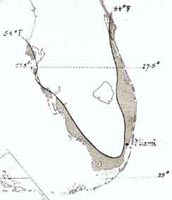| |
Introduction
ENP Lichen Volunteer Project Images-Click
Here
A small part
of South Florida has a unique flora and climate, when compared to the rest
of the United States and Canada. Globally, it is more closely related to
tropical areas of the World. But since it is wholly situated north of the
Tropic of Cancer, we use the term Subtropical Florida when referring to
it. It is defined as the part of Florida with an average January
temperature
 greater than 54°F.
This appears as the dark area in the graphic to the left. The lichen flora is also different here
with graphid and pyrenolichens abounding, the former not being common on
the rest of the continent (north of Mexico). greater than 54°F.
This appears as the dark area in the graphic to the left. The lichen flora is also different here
with graphid and pyrenolichens abounding, the former not being common on
the rest of the continent (north of Mexico).
In contrast, foliose lichens are less common with Parmotrema, Physcia,
Dirinaria and the jelly lichens representing a large portion of this
growth form.
The marvelous self published works of Richard C. Harris (Some Florida
Lichens 1990 and More Florida Lichens 1995), although covering
northern Florida more extensively than southern, still
represent the vast majority of published material applicable to
Subtropical Florida. But much more needs to be done if the lichen flora of
this region is to be understood.
Within Subtropical Florida most native trees and plant communities of both
coasts have been lost to development having been replaced by structures,
cement, grass and palm trees of various species. However, the extreme southern
portion of the region has been preserved through the establishment of Big
Cypress National Preserve (570,000 acres) and Everglades National Park
(1,509,000 acres). The problem of surveying lichens in this vast expanse is one of
accessibility. Unique plant communities, each with at least a slightly (or
greatly) different lichen mix, are not easily reached by trails or roads
which are very few in number.
Common impediments include high water levels (necessitating wading in
sometimes waist deep water), alligators (not as much threat as everyone
perceives), poisonous snakes (most dangerous are the diamondback
rattlesnake and the cottonmouth water moccasin) and an extremely high
mosquito population at certain times of the year). In addition, the 1000's
of outer islands and unique beach flora of the Cape Sable region offer their own lichen assemblages but are accessible only by boat.
For the last 18 years we have spent at least 7 months a year in the
region studying all aspects of this environment except marine ecology. With the help of others, we hope eventually
to create a multifaceted lichen web site including taxonomy (with images, keys and interactive keys), a
glossary illustrated with images, lichen habitats (and why we need to
preserve them), the roll lichens play in the natural world, and man's link to
lichens. Finally, we want to create a CD to be distributed free to educational facilities. In short, like the other publications we
have created (nine in all), we hope this site will eventually have
something for everyone from the novice to the professional. If this
appears a daunting task, it is. But in
view of the tremendous interest in lichens generated by the
recently published prodigious work entitled Lichens of North America
by Brodo, Sharnof and Sharnof, it seems desirable to build upon
this interest. Despite environmental preservation movements of the last
few decades, we, as humans, still tend to think of ourselves as aloof from
the natural world and able to manipulate it to our own wants when, in
reality, it is the natural world that manipulates us. Lichen ecology
would be a great way to demonstrate this.
Site Arrangement
The lichen
index in the left hand frame contains all included lichens. Clicking
on a species brings up a photo of the thallus which in turn contains links
(directly under the species name) to other species photos if available.
The link is grayed out if there is no photo. Clicking "Lichens
Home"
above returns you to this page. The site is
designed with "frames". To print a section it is necessary to first
click in the section you wish to print.
Comments
Your comments
and suggestions would be greatly appreciated.
Mail me!
|
 greater than 54°F.
This appears as the dark area in the graphic to the left. The lichen flora is also different here
with graphid and pyrenolichens abounding, the former not being common on
the rest of the continent (north of Mexico).
greater than 54°F.
This appears as the dark area in the graphic to the left. The lichen flora is also different here
with graphid and pyrenolichens abounding, the former not being common on
the rest of the continent (north of Mexico).